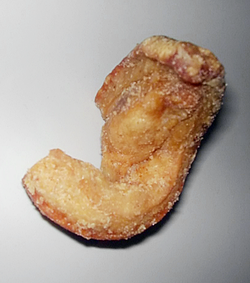Pork rind

A pork scratching from a bag purchased in the UK
|
|
| Type | Snack |
|---|---|
| Main ingredients | Pig skin |
| |
|
Pork rind is the skin of a pig. It is a common ingredient of sausages, which helps to improve their consistency.
It can also be fried or roasted in pork fat as a snack. The frying renders much of the fat that is attached to the uncooked rind, causing the cooked product to reduce considerably in size. This product may be known by alternative names, such as pork scratchings or pork crackling in the UK, although crackling may also refer to the rind on a roasted pork joint.
Often a by-product of the rendering of lard, it is also a way of making even the tough skin of a pig edible. In many ancient cultures, animal fats were the only way of obtaining oil for cooking and it was common in many people's diet until the industrial revolution made vegetable oils more common and more affordable.
Microwaveable pork rinds are sold in bags that resemble microwaveable popcorn and can be eaten still warm. Pickled pork rinds, on the other hand, are often enjoyed refrigerated and cold. Unlike the crisp and fluffy texture of fried pork rinds, pickled pork rinds are very rich and buttery, much like foie gras.
For the large scale production of commercial pork rinds, frozen, dried pork skin pellets are used. They are first rehydrated in water with added flavoring, and then fried in pork fat at 200–210 °C (392–410 °F). Cooking makes the rinds expand and float on the oil surface. The rinds are then removed from the fat, flavored, and air dried. Antioxidants may be added to improve stability.
Like many snack foods, pork rinds are high in sodium and fat, however, they are low in carbohydrates and are sometimes considered an alternative snack food for those following the Atkins diet. According to Men's Health, a one-ounce (28 g) serving contains nine times the protein and less fat than is found in a serving of potato chips, which are much higher in carbohydrates. They add that 43 percent of pork rind's fat is unsaturated, and most of that is oleic acid, the same healthy fat found in olive oil. Another 13 percent of its fat content is stearic acid, a type of saturated fat that is considered harmless because it does not raise cholesterol levels. A 60 g serving of pork rind contains 29 g of fat, 375 kcal and 0.65g of sodium. However, pork rinds are considered an incomplete source of protein because they contain very low amounts of some essential amino acids, including methionine, tryptophan and histidine.
...
Wikipedia
